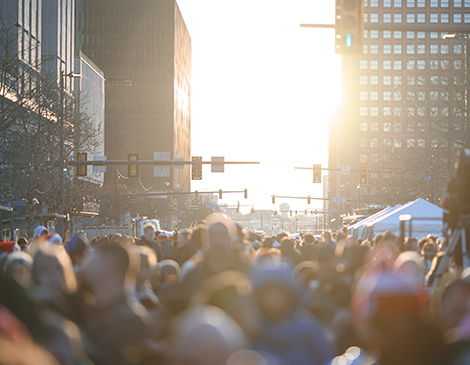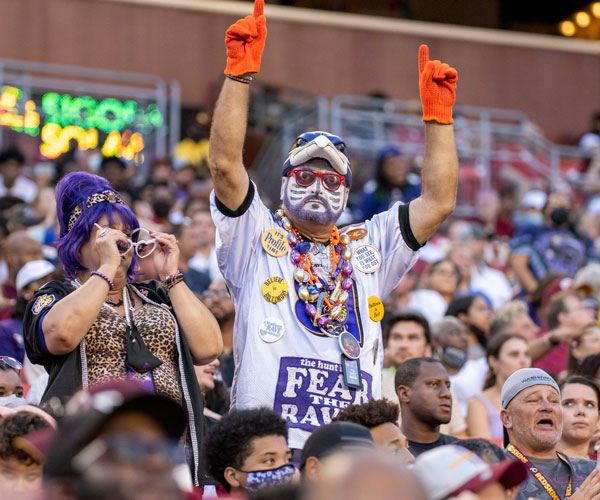The year: 2016.
The Cleveland Cavaliers had just won their first-ever NBA Championship in one of the most nail-biting games in basketball history.
Downtown Cleveland was alive.
From the Flats to Campus District, thousands of people spilled out from the city’s restaurants, bars, hotels, and their homes and into the streets to join in the revelry of cheering, dancing, crying, high-fiving and hugging with one another.
Days later, a million more would return for a historic celebratory Championship Parade.
Pride oozed from every Clevelander, but it was more than a game that inspired the depth of that emotion. It was the well-deserved, long-overdue recognition and validation of Cleveland’s big moment.
That energy and desire to be in the heart of the city continued through the summer. The national spotlight shone brightly. The Republican National Convention came to town. Long-standing businesses reported banner years. New businesses opened. Sherwin-Williams announced it would build a new downtown headquarters next door to Public Square’s own revitalization. More and more people started moving in and residential development bloomed. In 2019, Destination Cleveland reported a record-breaking county visitor number of 19 million.
Then COVID-19 came knocking.
The question now in 2023 is: Is Cleveland’s foot traffic rebounding enough to pick up that pre-pandemic momentum and run with it?
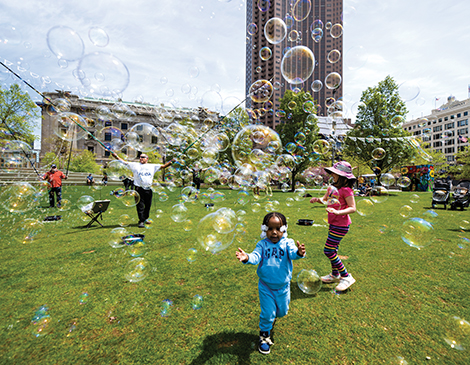
(Photo courtesy Erik Drost)
Slowed to a Slump But Hung On
The pandemic was like a needle that poked a hole and let the air out of Cleveland’s mightily proud balloon.
The dawn of the social distancing and work-from-home era kept commuters at bay. By April 2020, hundreds of small businesses closed. Frustration and disappointment mounted, and damage from the city’s civil unrest, as well as supply-chain shortages, forced extended closures of businesses and other attractions — all of which gave people even fewer reasons to go Downtown.
In October, Cleveland took another gut punch after WalletHub’s “Fastest-Growing Cities in America” study came out, ranking Cleveland 65th out of 66 cities for rapid economic development.
“When we look back to the past decade of growth, pre-pandemic … We remember moments … that really felt like, ‘Wow, everyone’s looking around and realizing there’s a tone change in the city,’” says Audrey Gerlach, vice president of economic development for Downtown Cleveland Alliance (DCA).
Yet while major cities around the country faced the same challenges, Cleveland fared comparatively well in Ohio compared to other metros like Columbus, Dayton, Cincinnati and Akron, Gerlach argues.
“We were so ahead of developing a residential population,” she says. “We have the largest residential Downtown population in Ohio.”
The “build-it-and-they-will-come” strategy for residential units is a major play developers and corporations are taking in 2023, which in turn could bring more lifeblood into the streets of downtown Cleveland.
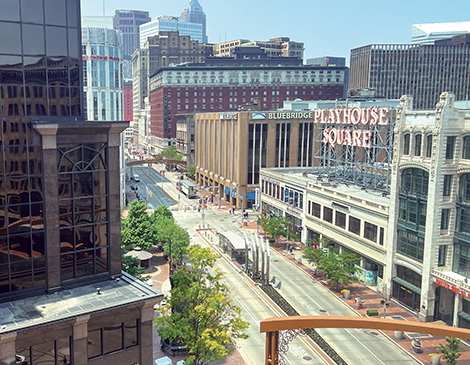
(Photo courtesy Erik Drost)
Survey Says: People Want to Live Downtown
Downtown’s residential population is around 20,000 — 22% higher than it was in 2013.
What’s more, Downtown’s residents live Downtown because they want to, and not because they work there, according to a study published by Downtown Cleveland Alliance and the Greater Cleveland Partnership in March. In fact, more than half of the area's residents work outside of the city.
“The data bears out,” Gerlach says. “There is more demand than we even can currently meet.”
The demand to work downtown, however, hasn’t been as strong. Office occupancy is hovering around 55% — a 3% decrease from last year.
Companies are re-envisioning that office space to meet the housing demand.
Playhouse Square, for example, recently announced it will create 84 apartment units from four floors of its Bulkley Building, with construction starting in July.
Other developers are looking to historic and other tax credits for doing the same.
“One of the gems of Downtown is our amazing architecture,” Gerlach says. “With that incentive, we’ve been able to turn some of those old empty office buildings into apartments.”
The former Ohio Bell building at 45 Erieview Plaza is one such example, which received a $5 million historic tax credit and is set to house 367 units by 2024.
The Agora Theatre complex was awarded a $250,000 historic tax credit for $1.6 million in renovations that will also include apartment units.
Millennia Companies received a $40 million Transformational Mixed-Use Development tax credit award last year to rehab the 1.4-million-square-foot, 100-year-old former Union Trust Building on Euclid Avenue, called The Centennial.
The Centennial, which has sat vacant for six years and is set to start construction this year, will include 413 workforce housing units and 177 market-rate luxury units in addition to hotel units, a museum, a high-end restaurant and retail storefronts.
“There will be easily over 350 jobs created to boost the economy, help the surrounding small businesses downtown, and generally create more energy,” says Tom Mignogna, the vice president of Millennia Housing Development, Ltd. “But we’re also excited about the mixed-income [housing] opportunity as well.”
Gerlach says that while rental housing is on the rise, current and prospective residents increasingly want for-sale housing to be available Downtown and they're coming up short. Projects such as Residences at the Guardian are in the works; however, Gerlach notes that, “I think we need to effectively prove to the market that there is a demand for for-sale housing. And I suspect as people build those projects and they sell, more builders will be interested in building for-sale housing.”
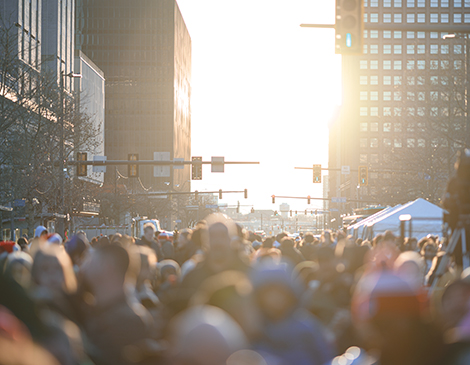
(Photo courtesy Erik Drost)
‘People Stop Exploring Their Own City’
Emily Kovach opened Intro Boutique with her sister, Elaina, in 2016.
Located at 5th Street Arcades with a Prospect Avenue storefront, the shop offers women’s clothing, accessories and home goods by women-owned ethical and sustainable brands, many of them local.
“We had three and a half years, approximately, before the pandemic, and they were golden,” Kovach says. “I was like, ‘This is it, it’s all up from here.’”
Intro Boutique had its best month yet in January 2020, but when the world shut down, the transition to selling items online was tough.
“When people come in my shop, I feel like I’m not selling to them. I’m just making a new friend and hanging out and being their hype girl. I can’t do that online. … I think it’s just because the shop is about personality. It’s about my sister and I, and how much we love it,” she says.
Kovach says that the months leading into this summer have been much better. “Sporting events, concerts, people coming out for dinner, we’re finally seeing that again,” Kovach says.
Today, Kovach and her sister are comfortable with where foot traffic stands.
But compared to pre-pandemic, she laments it will “probably never be the same.”
One of those reasons, she says, is that people from the suburbs don’t see the reason to come Downtown anymore aside from a quick bite to eat at a restaurant before a sporting event.
“People stop exploring their own city,” Kovach says.
Epa and Antoinette Bizimana, owners of Hydration Spark on Euclid Avenue, agree with that sentiment.
Hydration Spark opened in February 2022 and offers IV hydration, customized supplements and nutritional testing to optimize health and wellness. While a big part of their clientele are athletes, they also want to see the perception of downtown activities change.
Safety is another perception that needs to change in order to bring more folks back to the city, both Kovach and the Bizimanas say.
“[Officials are] trying to work hard in making the city more safe,” Antoinette says, but the onus also falls on business owners to be advocates to the city to convey that the city is changing, that business owners and residents do feel safe Downtown, and encourage others to come.
Outside the Box Thinking
DCA has been working with other community groups to host events throughout the city — from scheduled festivals to spontaneous bonfires or musical events that turn people’s heads and encourage them to
stop over.
But that starts with some unconventional thinking and planning ahead in ways that Gerlach calls “high impact but low cost.”
DCA recently purchased fire pits that can be moved to different locations to encourage people to gather — calling the events Bright Nights.
Food-truck pop-up events like Walnut Wednesdays in Perk Plaza have also made a comeback.
In what would bring a more structural change to the Downtown landscape, a 10-year-old project called the Midway Protected Bike Network would create 2.4 miles of protected bike lanes down the center of Superior Avenue from Public Square to East 55th Street.
Proponents say that it would make a wide road friendlier to bikers and pedestrians, and the greenery planted alongside the lines would make for an environmentally friendly landscape — though it has received backlash from the city for potentially being a nuisance to drivers.
For now, the Downtown community is moving forward with uncertainty — and cautious optimism — that better days are ahead. What’s certain is that Clevelanders’ resilience through the city’s peaks and valleys remains.
Get ahead of the weekend by signing up for our free weekly “In the CLE” newsletter — your guide to fun throughout The Land. Arriving in your inbox every Wednesday, this weekend to-do list fills you in on everything from concerts to museum exhibits — and more. Click here to subscribe.

